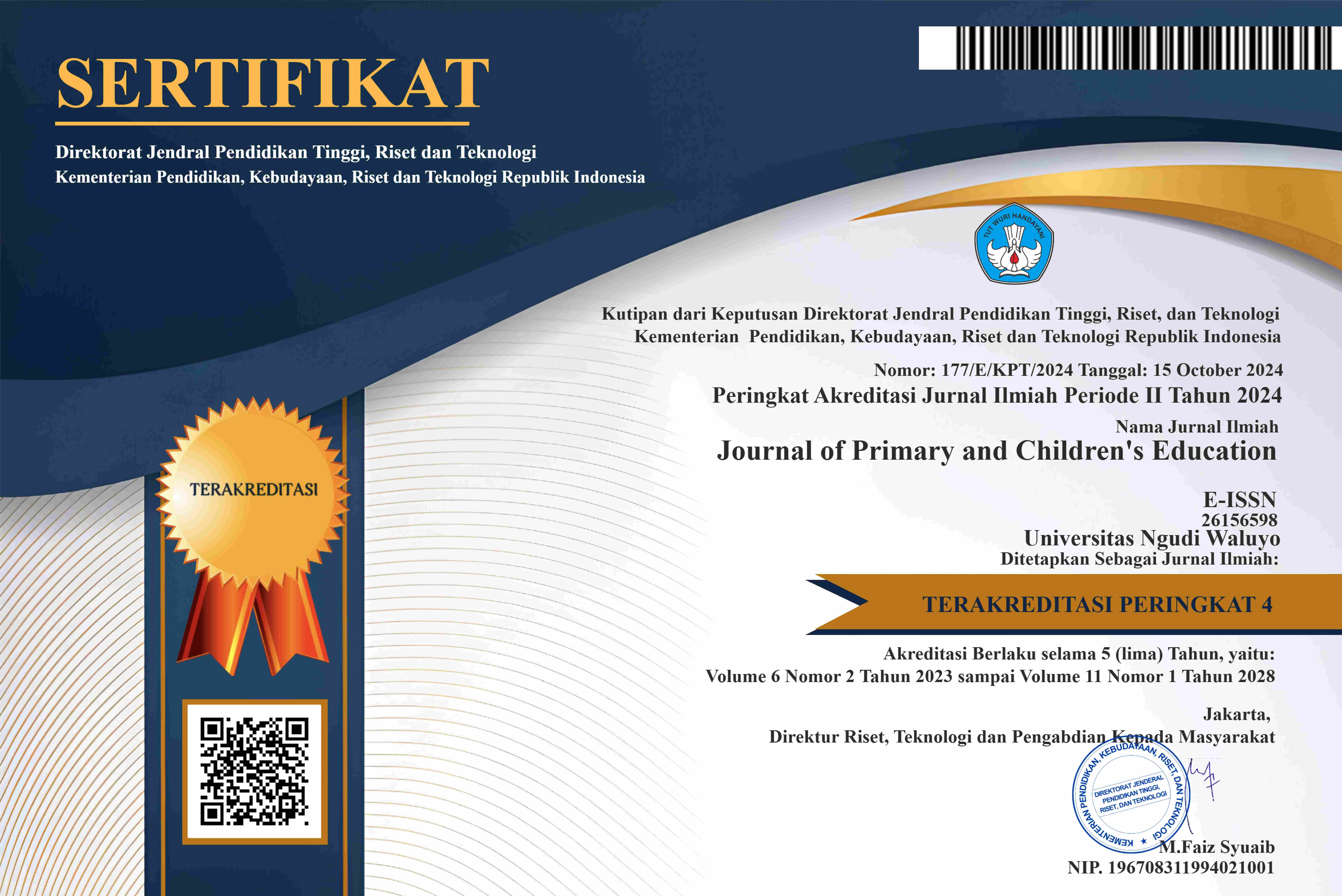Penggunaan Model Pembelajaraan Bamboo Dancing Dalam Meningkatkan Hasil Belajar IPS Siswa Kelas 5 SD
DOI:
https://doi.org/10.35473/jnctt.v2i1.188Abstract
The purpose of this study was to determine the effect of learning model bamboo dancing or dance bamboo on the result of study social science student of class V elementary school. This study uses the method of meta-analysis. After doing the calculation, the results of the study showed an increase learning outcomes social science student of class V by using the learning model bamboo dancing or dance bamboo ranging from a low of 19,53% to a high of 113% with an average 54,54%. It can be concluded that learning model bamboo dancing or dance bamboo can improve learning outcomes social science student of class V elementary school.
References
Ardianti ,dkk.(2014).Pengaruh Penggunaan Tipe Bamboo Dancing Dengan Hasil Pembelajaran IPS Di Kelas V. Jurnal Pendidikan dan Pembelajaran Volume 3 Nomor 8 2014. Diunduh 26 Maret 2018.
Candani, Dea Wahyu (2015).Upaya Meningkatkan Hasil Belajar IPS Melalui Model Pembelajaran Kooperatif Tipe Tari Bambu Kelas V Pada SDN-5 Pahandut Palangkaraya.Skripsi di publikasikan.[online].Universitas Muhammadiyah Palangka Raya Fakultas Keguruan Dan Ilmu Pendidikan
Dewi,Candra. “Implementasi Metode Bamboo Dancing Untuk Meningkatkan Hasil Belajar Ilmu Pengetahuan Sosial Pada Siswa Kelas V Sekolah Dasarâ€. Jurnal Ilmiah Pendidikan PraSekolah Dan Sekolah Awal Vol.1 No.1 2016
Hanafiah,N. 2009. Strategi Pembelajaran.Bandung: PT Feika Aditama.
Hifdziyah, Nelly Ahviena.(2015).Penerapan Metode Bamboo Dancing Untuk Meningkatkan Hasil Belajar Siswa Kelas V Pada Mata Pelajaran Ips Materi Pokok Tokoh-Tokoh Penting Dalam Peristiwa Proklamasi Kemerdekaan Indonesia Di Mi Ta’mirul Wathon 01 Sikancil Larangan Brebes. Skripsi di publikasikan [online]. Semarang: Fakultas Ilmu Tarbiah Dan Keguruan Universitas Islam Negeri Walisongo Semarang.
Nurjanah,Siti.(2017).Penerapan Model Pembelajaran Kooperatif Tipe Tari Bambu Untuk Meningkatkan Aktivitas Dan Hasil Belajar IPS Siswa Kelas V SD Negeri Metro Barat. Skripsi di publikasikan [online]. Bandar Lampung: Fakultas Kegurun danIlmu Pendidikan Universitas Lampung.
Nurazizah.(2016).Penerapan Model Pembelajaran Kooperatif Tipe Bamboo Dancing Untuk Meningkatkan Hasil Belajar IPS Siswa. Skripsi di Publikasikan. [online] Jurusan Pendidikan Guru Madrasah Ibtidaiyah Fakultas Ilmu Tarbiah Dan Keguruan UIN Syarif Hidayatullah Jakarta.
Pebrianita, dkk. Pengaruh Model Kooperatif Tipe Tari Bambu Terhadap Hasil Belajar IPS di SD. http://jurnal.untan.ac.id/index.php/jpdpb/article/viewFile/24836/75676576263
Sitindaon, Rommanna. 2017.Peningkatan Kualitas Pembelajaran IPS Melalui Model Pembelajaran Kooperatif Tipe Bamboo Dancing. Jurnal Antropologi Sosial dan Budaya.2017.
Sutarna, Nana, Dian Kusdiana.(2017).Pengaruh Model Pembelajaran Bamboo Dancing (Tari Bambu) Terhadap Hasil Belajar IPS Siswa SDN 1 Cipedes. Jurnal Ilmiah Pendidikan Dasar Vol.II No.2 2017.
Udin S.Winataputra, dkk (2007). Teori Belajar Dan Pembelajaran.Jakarta: Universitas Terbuka.
Zuraida. 2015.Pembelajaran Bamboo Dancing Salah Satu Model Cooverative Learning Untuk Meningkatkan Proses Pembelajaran IPS Di Sekolah Dasar. Jurnal Ilmiah Ilmu Pendidikan, Vol.XV No.1 April 2015. Di unduh 26 Maret 2019.
Published
How to Cite
Issue
Section
License
Copyright notice:
- Authors retain copyright and grant the journal right of first publication with the work simultaneously licensed under Creative Commons Attribution License that allows others to share the work with an acknowledgement of the work's authorship and initial publication in this journal.
- Authors are able to enter into separate, additional contractual arrangements for the non-exclusive distribution of the journal's published version of the work (e.g., post it to an institutional repository or publish it in a book), with an acknowledgement of its initial publication in this journal.
- Authors are permitted and encouraged to post their work online (e.g., in institutional repositories or on their website) prior to and during the submission process, as it can lead to productive exchanges, as well as earlier and greater citation of published work (The Effect of Open Access)







